Category: Idaho Army National Guard
Cyber warriors train alongside key state partners
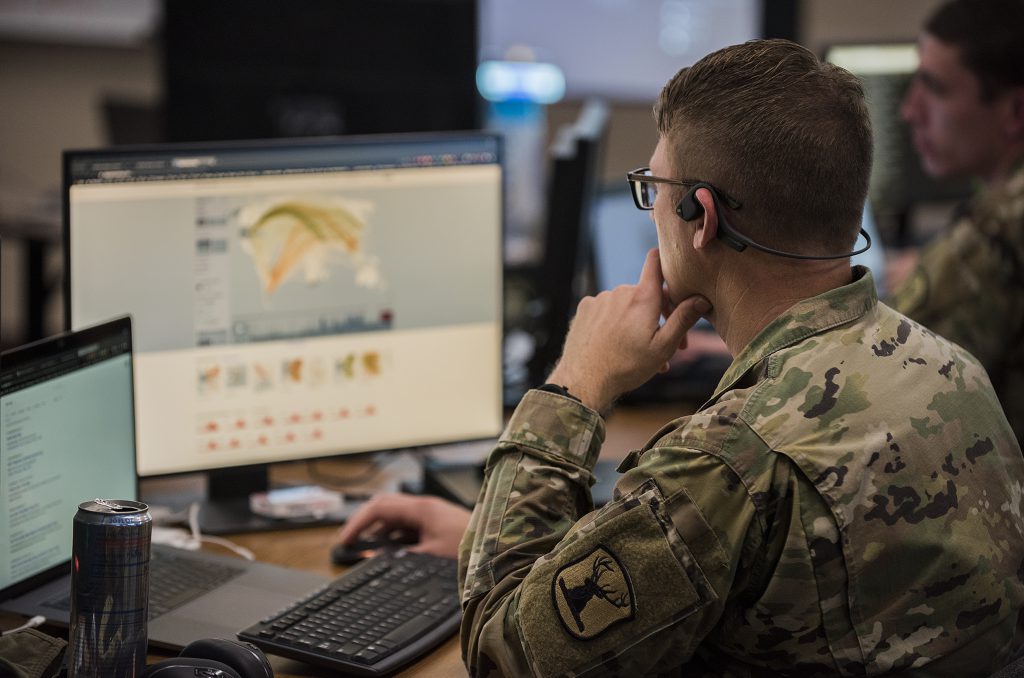
More than a dozen Idaho Army National Guard Soldiers participated in the National Guard’s Cyber Shield 20 exercise Sept 12-27. Members of Idaho’s Defense Cyber Operations Element were among nearly 600 Soldiers from more than 40 states who participated in the two-week training event.
The defensively focused tactical annual cyber exercise was hosted virtually this year and gave Idaho Soldiers the chance to develop and use their cyber defense skills while building key relationships with the state’s Office of Information Technology Services, its mission partner, during the exercise.
“We ensure the state understands our capabilities and that if called upon, we can respond within the legal bounds of cyber defense,” said Col. Dan Lister, IDARNG Chief Information Officer.
During the exercise, each team worked with a mission partner representing an industry partner. Teams assessed networks for vulnerabilities and assisted in recovery operations after a cyber incident.
“It sharpens the skills of our cyber-warriors, who hone their skills throughout the year and the come here ready to lock and load on their weapon systems, their computers,” said Maj. Eric Burgan, the team’s deputy team chief.
Teams spent the first week of the exercise training on cyber threat analysis, systems analysis, information control systems and information operations. The second week tested Soldiers’ skills while conducting cyber incident response and network defense operations.
In previous years, the exercise focused on a weeklong scenario held in person at a central location, but with teams spread out across the country to accommodate Covid-19 safety restrictions, exercises focused on two vignettes per day, which were designed to test specific skill sets.
Burgan said training alongside the state’s IT office allows the team to build trust at the top level that extends to Idaho’s local cities and counties. Across the nation, National Guard DCOEs work with public partners to asses vulnerabilities and help protect public networks.
Idaho’s DCOE stood up in 2016 with the intent to train with community partners and respond to any cyber emergencies within the state, similar to other emergency missions the Idaho National Guard performs.
Back to Newsroom
JOIN the Idaho Army National Guard
39 former Marine Reservists enlist into the Idaho Army National Guard
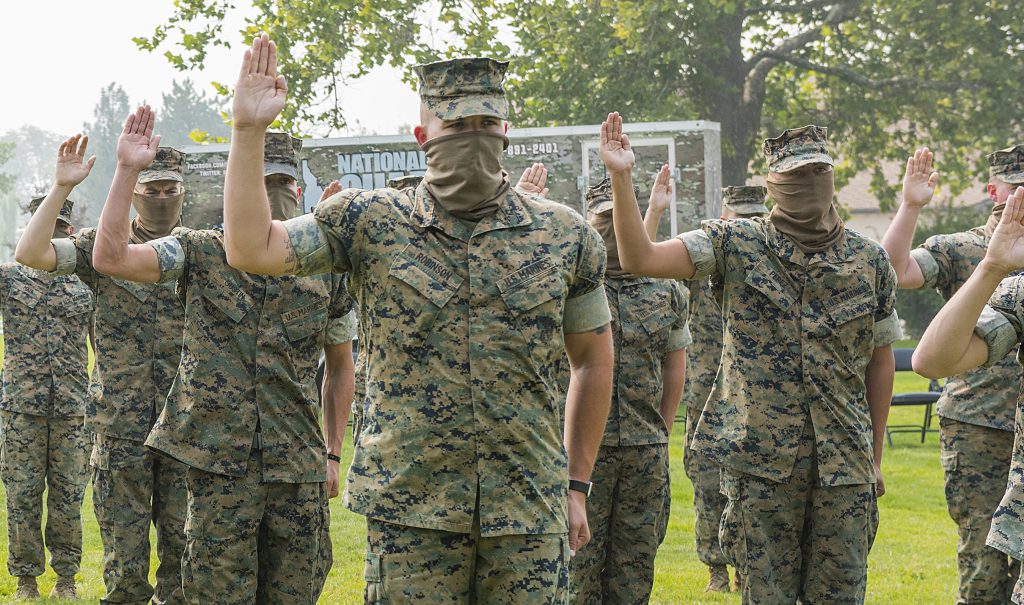
Today, more than three dozen former Marine Reservists enlisted into the Idaho Army National Guard. Idaho’s newest Citizen-Soldiers all served in Company C, 4th Tank Battalion, which was deactivated in August as the Marines look to divest its armor battalions.
“Marines make excellent Soldiers,” Brig. Gen. Farin Schwartz, commander of the Idaho Army National Guard said. “They each have the potential to make an immediate impact to their new unit and have already proven to be successful in the military.”
New recruits can take six to eighteen months to train before they can reach their assigned unit and once there, must continue to train and learn their new job before they can fully contribute to their unit’s mission. Most of the Marines who transferred into the National Guard will have similar positions when possible, Schwartz said.
Marine 1st Sgt. Craig Wilcox said more than a third of the company’s Marines transferred into the Idaho Army National Guard for one of two reasons: to continue to serve their country locally or to continue to work on or in tanks. Company C operated the M1A1 Abrams Main Battle Tank while the 116th Brigade Combat Team of the Idaho Army National Guard operates the updated M1A2 Sep v.
“I looked at all of my options and I knew I wanted to stay in Idaho because my family is here,” said Staff Sgt. Kyle Dycus, one of the Marines who transitioned into the Idaho Army National Guard. “Initially, I wanted to stay within the tank community but decided to look for a more real-world option for my future and I chose the information technology field. I am looking at this from a positive aspect and I am thankful for this new opportunity. Change can often be a good thing.”
The majority of the Marines who enlisted into the Idaho Army National Guard are tankers, maintainers and other support individuals.
“We tried to match their Marine skill sets to an Army military occupational specialty as much as possible,” Schwartz said. “And we’ll continue to pay them special attention for the foreseeable future to ensure their transition is as smooth as possible.”
Wilcox said Marine Reservists were given the option of transferring to a new job and unit in the Marine Reserve, to transfer to a new branch or join the Individual Ready Reserve. An additional 10 Marines joined National Guard units in other states.
The number of Marines to transition into the Idaho Army National Guard increases the total strength of the organization by more than a percent.
In 2019 the Marines began divesting its tanks and reducing its artillery cannon battalions to focus on developing light mobility options to get around island chains with the assistance of unmanned systems and mobile anti-ship missiles. The efforts are part of Marine Corps Commandant Gen. David Berger’s plan to modernize the corps to become a lighter and faster force.
The Marines also plan to reduce its number of infantry battalions from 24 to 21, artillery cannon batteries from 21 to five and amphibious vehicle companies from six to four.
Locally, Wilcox said that a small number of Marines will remain on Gowen Field to maintain the Marines’ connection to the Treasure Valley until a decision is made regarding future units being assigned to Gowen Field. In the meantime, Marines will continue to engage in community relations events, host their annual Toys for Tots program and conduct funerals and honors for Idaho’s Marine veterans.
Back to Newsroom
JOIN the Idaho Army National Guard
Idaho National Guard assists California with wildland fires
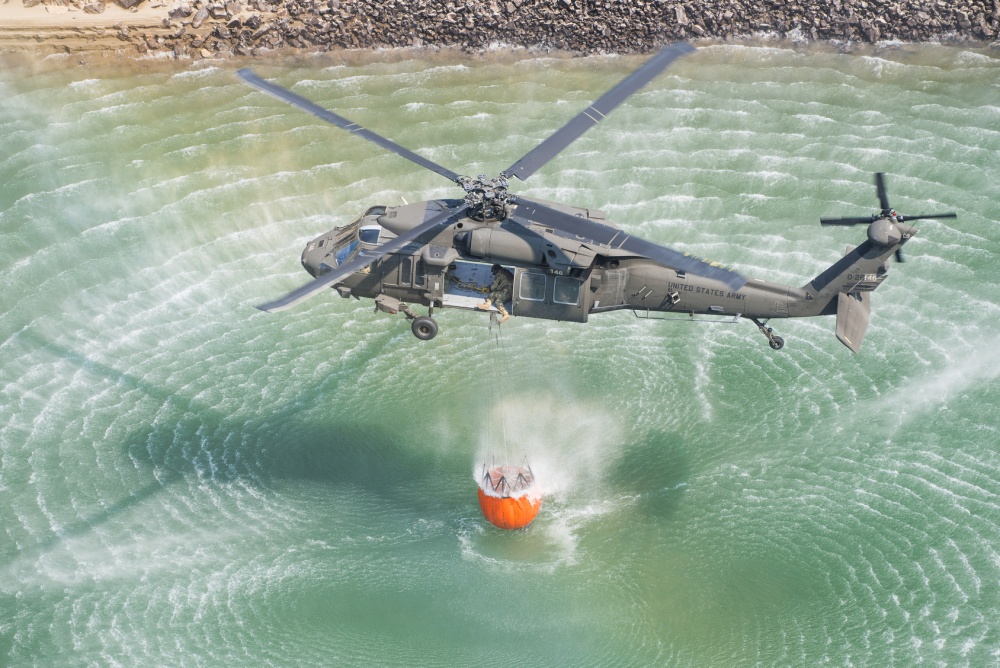
The Idaho National Guard sent three UH-60 Black Hawk helicopters and nearly two-dozen personnel on Aug. 27 to assist in battling the California wildfires. Earlier in the week, the Idaho Army National Guard Aviation Group trained on the specialized bucket equipment unique to helicopters and designed specifically for aerial firefighting.
“California is currently requesting six Type-1 Firefighting Aircraft and we’re one of the only units currently available to fulfill that request,” said Col. Christopher Burt, Idaho Army National Guard state aviation officer. “We are trained, ready and eager to help our neighbors in California.”
The team from Idaho includes pilots and crew chiefs who make up the flight crews, along with essential maintenance and support personnel, as well as two flight paramedics augmenting California National Guard UH-60 MEDEVAC crews. They will work in cooperation with several other states as they battle the massive fires that have already consumed more than 1 million acres across the Golden State.
“Our UH-60s are three of nearly 80 civilian and military aircraft from around the nation supporting this crisis response,” said Capt. Eric Fitzpatrick, officer in charge of Idaho’s team. “Civilian aircraft are the primary effort but they have reached capacity so this is where the National Guard comes in: to help fellow citizens in need, whether back home in Idaho or around the country.”
While Idaho Army Aviation provides this support to the citizens of California, the Idaho National Guard as a whole continues to maintain its readiness to respond to fires, or any other emergencies here in Idaho, if called upon.
Idaho National Guard responds to three search and rescues
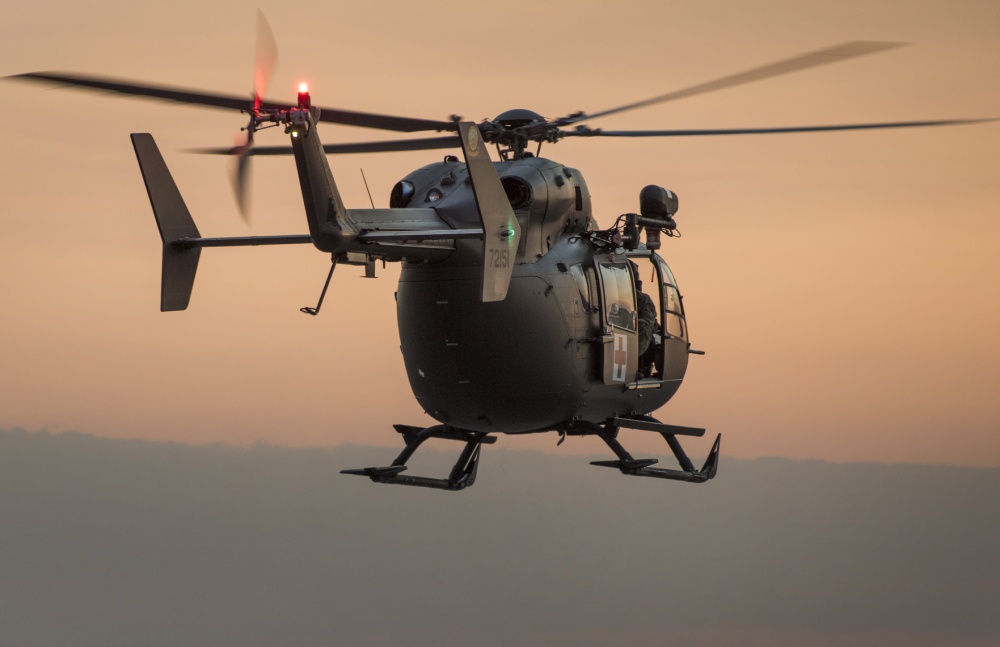
Article courtesy KIVI Channel 6
BOISE, Idaho — The Idaho National Guard has the capability to fly either their Black Hawk or Lakota helicopters into the Idaho backcountry for search and rescues.
On Thursday morning, a team responded to a remote area in the Idaho City area after a person riding an ATV crashed, the other two rescues from the past week included hikers.
The Idaho National Guard used a hoist recovery and flew these three people out of the backcountry to receive the medical care they needed.
“We don’t get the information too much on the why’s or the how’s, we get the approval to go and we are always willing to go help,” said Army National Guard pilot Nathan Spaulding. “It is really rewarding.”
A rescue begins with authorities in rural Idaho calling for extraction, then if crews are available, they start planning out the logistics.
“Location is an important one because we got to get to the right spot and sometimes that can be a challenge,” said Army National Guard pilot Mitchell Watson. “We want to know things like elevation, temperature, how many are injured, and the nature of their injuries.”
While communicating with ground crews, the two pilots assess the situation, in these rescues, the hoist operator lowered the medic down to the injured person.
“Then the medic will typically package the patient, put them in some type of litter,” said Watson. They will call us back then we will hoist out the patient and the medic.”
This four-person crew relies on training to hone their skills to ensure a successful mission in some of the most challenging terrain in Idaho.
“We are making a difference, and that’s why I think I like it,” said Watson.
Impact summer: High school student spends summer at basic training, preparing for future
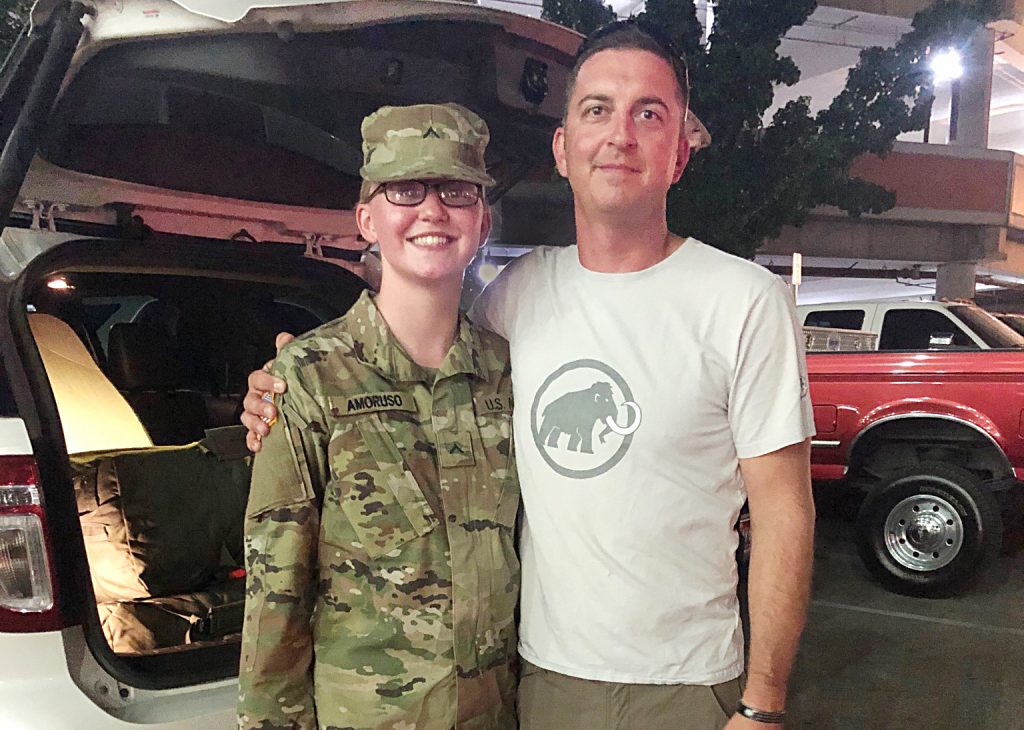
Capt. Robert J. Taylor
Idaho Army National Guard
Idaho Army National Guard Pvt. Ashlynn Amoruso grew up wanting to be a surgeon. Over the summer, she took a big step toward accomplishing that goal by completing basic combat training at Fort Jackson, South Carolina.
“I asked my friends, ‘what did you do this summer?’ and they said they didn’t do much because of Covid-19,” she said. “I did a lot of things I never expected I’d do.”
Amoruso enlisted into the Idaho Army National Guard in December and is still 17. She’ll start her senior year of high school today and continue both her military and civilian education after graduating in May.
“Being in the National Guard is really cool,” Amoruso said. “I don’t think I’d want to go active duty. My dad’s in the National Guard and has done a lot of things, and I thought that was really cool.”
Like her father, 1st Sgt. Dan Amoruso, Pvt. Amoruso will serve as a 68W combat medic. She said she’s always been fascinated with being either a trauma or neurosurgeon after reading books and watching videos about doctors while growing up. She plans to earn her EMT certificate during the school year, which will reduce the length of time she’ll need to spend at Fort Sam Houston in San Antonio, Texas, training to become a medic.
Amoruso plans to start college at Boise State University after she graduates high school and completes Advanced Individual Training. As a member of the Idaho National Guard, she’ll be eligible for both Federal Tuition Assistance and the State Assistance Tuition Program. Each program will provide up to $4,000 a year in tuition and/or fees. Boise State currently charges $2,766.18 a semester in tuition and an additional $1,263.82 in fees. She is also eligible to use the GI Bill to help cover living expenses while in college, in addition to her monthly drill paycheck.
“I’m proud that my daughter joined the Idaho Army National Guard,” said First Sgt. Amoruso. “I think she saw the positive things the National Guard has done for our family as she grew up, and that influenced her decision to enlist.”
Basic training was Pvt. Amoruso‘s first time visiting somewhere on the East Coast. She enlisted as part of the National Guard’s Split Training Option, which allowed her to attend basic training between her junior and senior years of high school. She’ll attend Advanced Individual Training after she graduates high school.
“It taught me a lot about dealing with other people,” she said. “I met people from all over the U.S. and interacting with them was different than interacting with people here in Idaho.”
During basic training, she repelled from a 40-foot wall, spent weeks learning how to fire the M4 rifle, and learned the basics of being a Soldier, including marching, physical fitness and the Army values. Amoruso said her favorite part was learning to throw a grenade.
“It was super loud and you could feel it,” she said. “You could never pull the pin out with your teeth like they do in the movies.”
Back to Newsroom
JOIN the Idaho Army National Guard
A day in the life of a rescue helicopter pilot
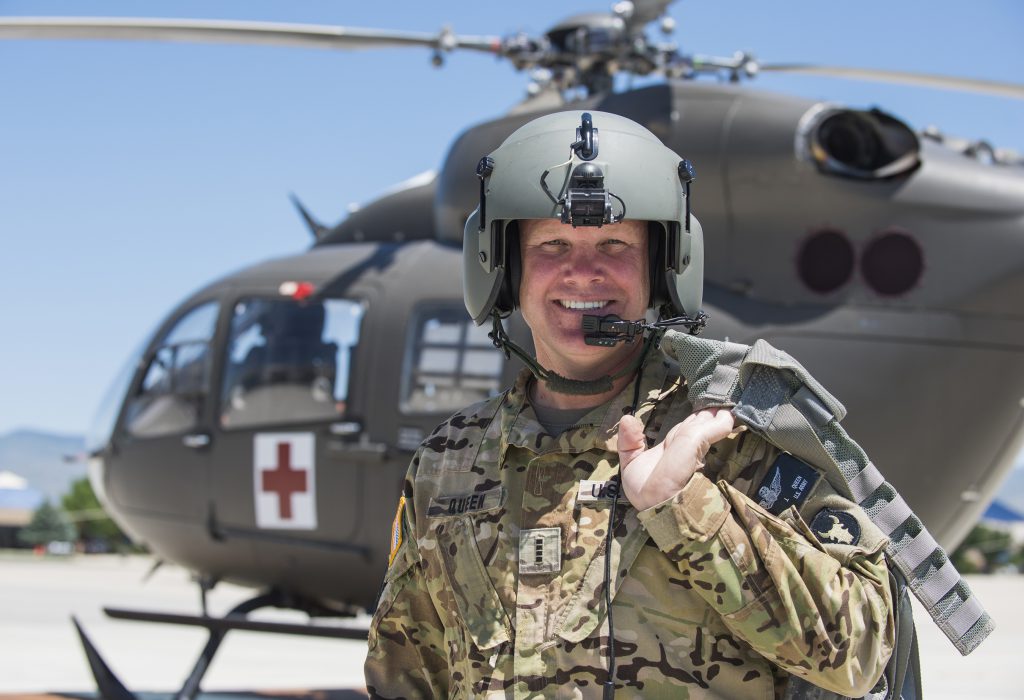
By Master Sgt. Becky Vanshur
Idaho Military Division Public Affairs
Spend a day with Idaho farmer and Guardsman Chief Warrant Officer 4 Chad Queen, one of the Idaho Army National Guard’s rescue helicopter pilots, and feel firsthand what it is like to fly the UH-72 Lakota helicopter and help save lives.
The clunking and puttering sounds of the tractor are too loud and the vibration from the engine on his leg masked the familiar feeling of the phone ringing in his pocket so he missed the call. Not 30 seconds later, his wife is running toward him from the ranch house with a phone in her hand and her arms waving above her, motioning for him to stop, as he is barreling down a row of overgrown hay.
Queen brings the tractor to a halt and idles the engine. He takes the call from his wife’s phone. An Idaho National Guard flight operations officer is on the line. “We have a possible rescue, can you assemble a crew?” A crew consists of the pilot, a crew chief and a paramedic. Today, there are two individuals lost on the South Fork of the Boise River near Elmore County, north of Mountain Home, Idaho.
It is a warm summer day, just after 10:00 a.m. on a Saturday. Queen leaves his tractor in the field and rushes to change out of his dusty farm clothes and into his flight suit. He calls his crew to help, kisses his wife and gets into his car, all within a few minutes. Queen calls the flight operations officer. “We are 30 minutes out.”
“I am always pleased when I can assist with a rescue mission, it is a great way to serve my local community,” said Queen. “With over thirty years in the Army, I have had a lot of assignments, but none so rewarding as this.”
The previous evening three individuals flipped in their raft on the river. One individual was able to pull himself out of the water safely, walking several hours to find a phone around midnight and call for help. He did not see his two friends get out of the river. Air St. Luke’s flew up and down the river throughout the night, unable to find either of the individuals. Elmore County Search and Rescue set up a command center nearby and started the ground search.
As soon as Air St. Luke’s and the Elmore County Search and Rescue realized the lost individuals could be down in a river canyon and unreachable, they requested the Idaho Army National Guard’s UH-72 Lakota helicopter. They called the Air Force Rescue Coordination Center dispatch, located in Florida, for assistance. The AFRCC approved the mission and called the Idaho National Guard flight operations officer.
Idaho’s two UH-72 helicopters belong to the IDARNG Detachment 1, Delta Company, 112th Service and Support Battalion. They have a unique hoist and lift rescue attachment and are strictly used for domestic operations and rescues.
Queen and his crew arrive at Gowen Field, Boise’s Air Terminal and National Guard base, around 10:30 a.m. and begin preparing the helicopter for its flight. Using a preflight checklist, Queen ensures the fuel amount is accurate for the mission with the weight of the crewmembers and the additional approximate weight of the rescued individuals.
The crew chief ensures the aircraft is ready for the mission and Queen gathers the map, the route and coordinates, weather data and any other information needed from a preflight brief with the flight operations officer.
The helicopter is ready and crew are ready. They grab their personal survival bags, helmets and harnesses. Queen is sitting in the cockpit and taxis the helicopter onto the open space of the flight line. He lifts up on the collective and brings the helicopter a few feet above the ground for several seconds, performing a hover check to calculate power requirements with the combined calculations of weight adjustments, weather, altitude and fuel amount.
Queen performs final radio checks and they take off high into the air, heading east away from Gowen Field, toward Mountain Home.
Queen speaks through his headset. “Five minutes out from the location site.” The crew chief attaches his tether to the tether of the hoist. He tugs on it firmly, going through the motions of several series of operational checks on the equipment. The hoist equipment is ready.
Both the crew chief and the paramedic hang out of the helicopter on the ledge of each side, searching the ground below them, their feet resting on the skid platform of the helicopter. The helicopter blades are rotating loudly above them.
They search deep into the gulches near the river. They fly up and down the river, searching in the water and alongside the riverbanks at a low altitude and low air speed.
Two individuals are spotted walking on a dirt road in a narrow canyon area. Queen lands in a nearby opening. The paramedic jumps out of the helicopter and runs to the two individuals. Fortunately, they are the lost individuals and are only suffering from minor injuries and dehydration.
The individuals are rescued without the need for the hoist equipment and first aid is performed on them as they fly back to the command center where ground ambulances and a large excited group of family members and friends are waiting, cheering as the helicopter lands.
It is nearing 1:00 p.m. and Queen flies the helicopter back to Gowen Field. He and his crew feel a release of tension to know they successfully helped in the rescue of the two individuals.
Queen and his crew train for daytime and nighttime scenarios and with different rescue agencies such as fire departments, sheriff offices, forest rangers, wildland firefighters and other first responders.
“The crew can respond to assist with several emergency situations like floods, fires and mountain rescues,” said Queen. “We train with local first responders to assure proficiency for when it counts.”
Queen taxis the helicopter toward the hanger at Gowen Field. He and his crew perform the post flight checklist and debrief, positioning the helicopter in the hanger, preparing it for the next rescue.
Queen drives up his gravel driveway hearing the familiar crisp sound of the rock under his tires. It is late in the afternoon now. He quickly eats a sandwich, changes back into his farm clothes and walks up the already swathed row of hay, toward his tractor. He climbs into his tractor and begins barreling down the row that he had abandoned earlier, feeling the warmth of the hot summer sunlight on his face and a sense of relief from the day’s successful rescue mission.
There’s a snake in my boot – Key military leaders assist with tagging and the study of rattlesnakes
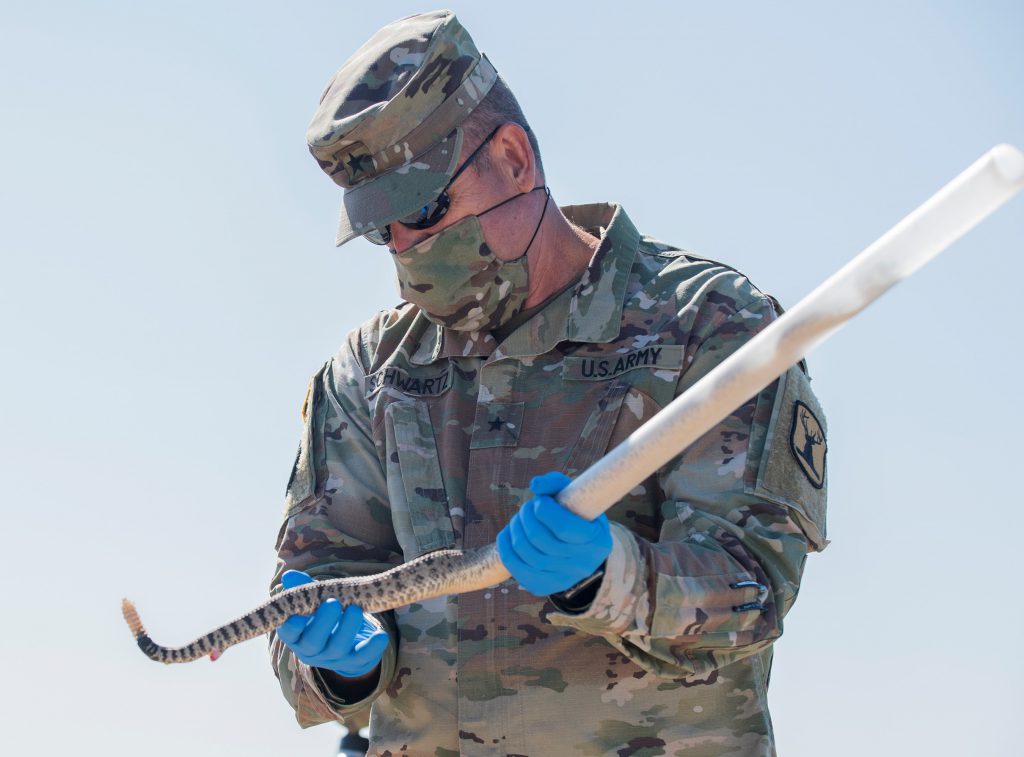
By Master Sgt. Becky Vanshur
Idaho Military Division Public Affairs
Although snakes did not end up in anyone’s boots as the popular phrase states, they did end up in key leaders’ hands. Idaho National Guard key leaders held rattlesnakes and assisted the Idaho National Guard Environmental Management Office biologists with tagging, studying and measuring rattlesnakes on July 8, at the Morley Nelson Snake River Birds of Prey National Conservation Area, locally known as the NCA.
Snakes have been an ongoing national and local interest with a legacy project directed by the Department of Defense due to a common snake fungal disease that affected preservation and spread in the United States. Biologists here continue to test and study rattlesnakes for the fungal disease.
“We train to protect our nation’s interests and the preservation of our environment is, and should be, one of our most important national interests,” said Maj. Gen. Michael Garshak, adjutant general of Idaho. “We don’t take care of the environment in order to train, we train to preserve the environment.”
The Idaho National Guard continues to partner with the Bureau of Land Management and other agencies to protect the NCA’s natural and cultural resources while simultaneously training in what is one of the largest northwest joint combined arms military training sites; the Orchard Combat Training Center.
The OCTC’s 143,000 acres has provided training grounds for the Idaho Army National Guard and air combat training for the Idaho Air National Guard, as well as neighboring states, since 1953.
The current program study, run by Boise State University graduate student, Kristina Parker, is a collaborative partnership between the IDARNG, BSU, U.S. Geological Survey and Northern Nazarene University, funded by the IDARNG. IDARNG biologists have collected data on the environment in the NCA, in accordance with Department of Defense requirements, as part of an ongoing comprehensive study of the land since 1987.
“Our data shows that the base of this environment, which is the vegetation, has had positive effects over this amount of time,” said Zoe Duran, Idaho National Guard Management Office biologist. “This is because of the resources we are able to put into wildland fire prevention and active restoration of the vegetation.”
The NCA is home to one of largest North American populations of breeding raptors, to include hawks, falcons, eagles and owls.
Idaho National Guard biologists conduct studies to ensure a robust and abundant diet for the birds of prey, like snakes, ground squirrels and lizards, which promotes conservation of the overall wildlife and their habitats within the NCA. The Idaho National Guard ensures the land is well-maintained with healthy vegetation to sustain a balanced ecosystem.
“The military has been known for doing a great job of maintaining their natural resources and conserving the natural landscape of their training areas,” said Kevin Warner, the Idaho National Guard’s Environmental Management Office natural resource specialist.
The NCA is a unique place in Idaho that can sustain the natural birds of prey and other wildlife, while sharing the land with livestock, public land use and military training at the OCTC.
Idaho National Guard key leaders and biologists recorded the health of each of the rattlesnakes they studied and tagged new snakes they found. Fortunately, no one ended up with a snake in his or her boot and the ongoing efforts of good environmental stewardship continued by gaining valuable data from another successful day in the NCA.
Idaho Guardsmen train to fight wildland fires earning Red Card certifications
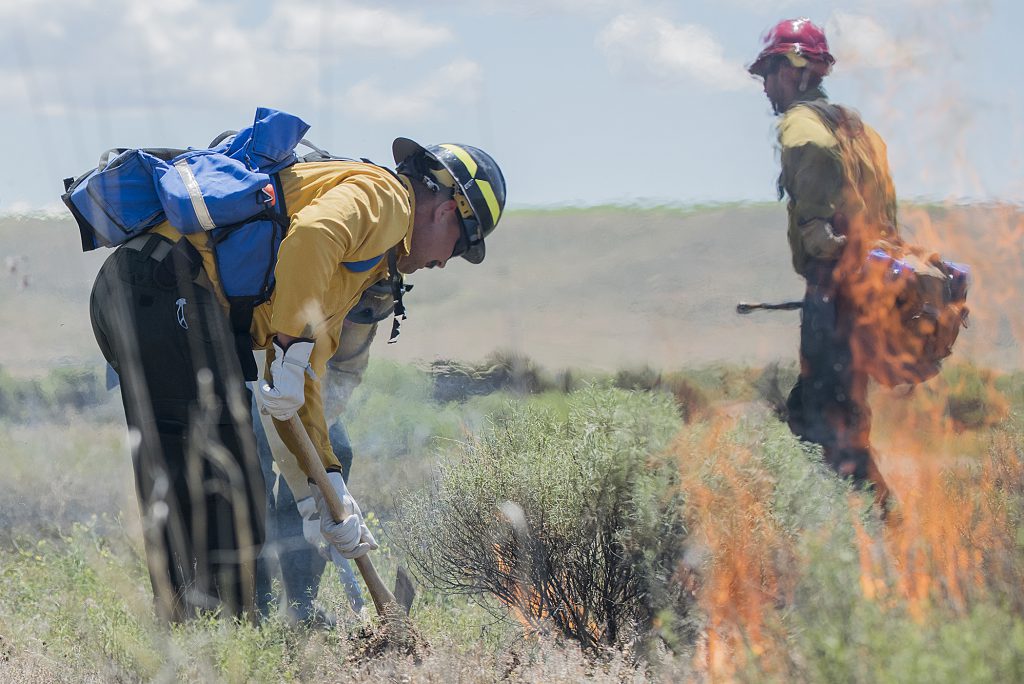
By Master Sgt. Becky Vanshur
Idaho Military Division Public Affairs
Approximately 40 Idaho Citizen-Solders are now equipped with the knowledge and training to fight wildland fires, as the Idaho National Guard hosted its first wildland firefighting training course at Gowen Field, Idaho, June 15-19 and June 22-26.
Although Gowen Field and the Orchard Combat Training Center fire departments have qualified wildland firefighters, this is the first time the five-day courses have been offered to non-firefighter Guardsmen, enabling them the opportunity to earn an Incident Qualification Card, commonly known as a Red Card certification.
As Soldiers become certified by Idaho Department of Lands, they are prepared to assist firefighting efforts in the event the governor declares a state emergency. Additionally, it allows the Guardsmen the opportunity to learn a new skill they can use for job opportunities within the military or the civilian workforce.
“The Idaho National Guard is proud to offer our Soldiers the opportunity to participate in this entry-level firefighter course,” said Brig. Gen. Russ Johnson, director of the joint staff. “It enables us to enhance our capability to respond to local, state and federal calls with trained and qualified wildland firefighters.”
The Soldiers who were willing and able to complete training standards for this course are also willing and able to volunteer for state activation during the fire season, Aug. 1 through Nov. 30 of this year, if requested.
“We want to train and Red Card certify as many as 200-300 Guardsmen over the next several years,” said Lt. Col. Tony Vincelli, director of strategic plans for the joint staff. “It’s part of our overall strategy that the Idaho National Guard be prepared to support any domestic emergency.”
The week consisted of two online introduction courses leading into 32 hours of training in the Basic Firefighting and Wildland Fire Behavior courses and the demonstration of individual physical fitness by completing a pack test consisting of a three-mile ruck march carrying a 45-pound pack in less than 45 minutes.
“I have always been one to just go for it and volunteer for everything,” said Spc. Tatiana Campbell from Bravo Company, 116th Brigade Engineer Battalion. “As one of the few females signed up for the course, I was pretty impressed with the physical challenge of it. Physically it wasn’t too hard on me, but if you are physically fit, it’s going to be easier on you.”
National Guard Bureau provides funding for specific wildfire prevention and protection activities. These courses were offered at Gowen Field at no cost to the Idaho Guardsmen. When available, this funding is provided annually to Idaho and other western states prone to wildland fires.
“Wildland firefighting is something I have always wanted to do,” said Sgt. Nolan Myer from the 148th Field Artillery Regiment. “Within 45 minutes of getting the email that there was a wildland firefighting course being offered, I sent an email immediately back and signed right up.”
The IDL and the OCTC firefighters taught the course and at the end of each of the weeklong courses, the IDL certified those individuals who met the qualifications and issued their Red Cards. Every year those individuals can recertify to maintain their skills and Red Card certification.
“This unique training compliments the existing levels of specialized capability that currently exist in the Idaho National Guard,” said Johnson. “And it further reinforces our commitment to serving and protecting our great citizens.”
New Idaho Guard enlistees receive school tuition assistance, $20,000 bonus
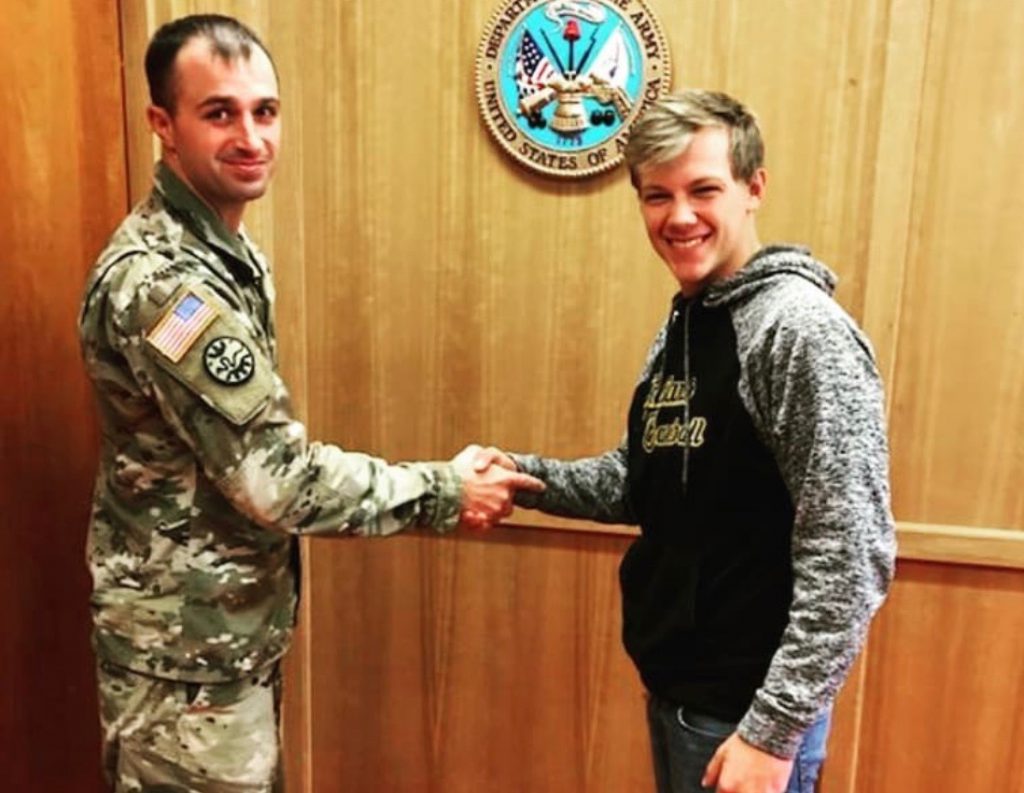
Story by Crystal Farris
Idaho Military Division Public Affairs
Idaho Army National Guardsman Pfc. Kolten Jordan needed a bit of direction in his life after graduating high school. Working full time in the construction industry just to make ends meet, he decided to find a more enjoyable career and a way to help pay for college.
“I really wanted to go to school to get a degree,” said Jordan. “After hearing that I could receive an enlistment bonus and college tuition benefits through the guard, I knew it would be a good direction to take in my life.”
Jordan enlisted as a cannon crew member with the 116th Cavalry Brigade Combat Team’s A Battery, 148th Field Artillery Regiment in November 2018. Upon joining, he received a $20,000 enlistment bonus, the Montgomery GI Bill Kicker of $350 per academic month and the ability to earn an additional $8,000 in annual federal and state tuition assistance.
Since returning from basic and advanced individual training, Jordan has started using his school tuition assistance to pursue an associate degree in fire science at Boise State University and has received $10,000 of his enlistment bonus.
“Receiving my bonus was one of the biggest reliefs I’ve ever had,” said Jordan. “The money has so far helped me pay for college, enabled me to give my girlfriend a good birthday and is still helping to keep me on my feet with bills while I focus on school.”
The Idaho Army National Guard is one of approximately five other states national-wide to offer a $20,000 non-prior service enlistment bonus as part of a new pilot program that began in October 2018. The organization has since signed 93 enlistees under the bonus.
“The bonus program is just one example of how the Idaho Army National Guard helps Soldiers accomplish whatever they want in their civilian life,” said Brig. Gen. Farin Schwartz, commander, Idaho Army National Guard. “The benefits of our organization make the Guard an easy first choice for Idahoans who want to serve their country while remaining close to home.”
The bonus incentivizes Soldiers to maintain good standing throughout their commitment by changing the way it pays over the course of six years compared to previous bonuses. Previous bonuses paid service members half their entitlement after completing advanced individual training and the remaining half in even allotments every two years for the remainder of their contracts.
While the new bonus also pays out half after AIT, service members now receive the second half in even allotments dispersed annually on the anniversary of their AIT graduation, but only if they are in good standing.
By issuing payments every year, the bonus gives service members money they can count on more frequently, said Sgt. Preston Hair, Idaho Army National Guard recruiter. It’s an added benefit to fulfilling requirements service members are already expected to meet regardless of a bonus, added Hair.
“I’ve always been someone who wants to get a job done well but the bonus payments definitely help motivate me to maintain good readiness standing with the guard,” said Jordan. “It’s always nice to receive a payment, especially for doing something that I absolutely love being a part of.”
To qualify for the enlistment bonus, individuals must meet various initial entry requirements, including: no prior military service, score above a 50 on the ASVAB and have either a high school diploma or a GED in combination with 15 or more college credits.
Additionally, enlistees must sign for six years and chose from a list of the organization’s 10 to 15 qualifying military occupational specialties.
The organization also offers educational incentives to those qualifying under the new pilot program bonus, including the Montgomery GI Bill Kicker of up to $350 per academic month and a student loan repayment program that pays up to $50,000 in previously acquired academic loans. This is in addition to $4,000 in federal educational assistance and $4,000 in state educational assistance service members are already entitled to per year.
Idaho National Guard sends 400 Soldiers to Washington D.C.
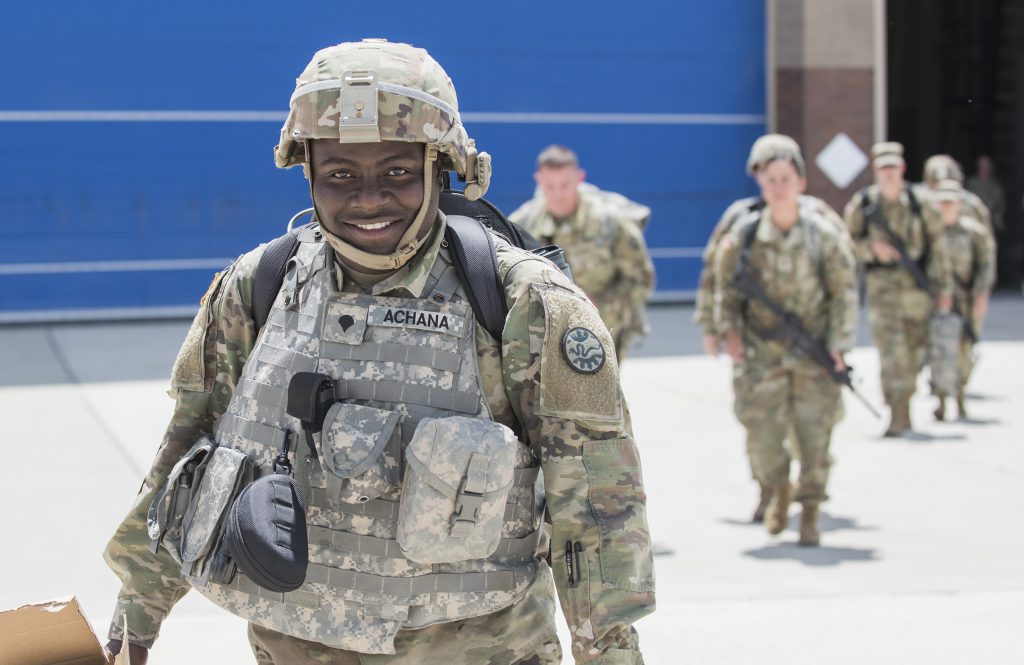
The Idaho National Guard sent approximately 400 Soldiers to Washington D.C. today to assist with guarding federal monuments, buildings and other property. The Soldiers will augment the D.C. National Guard and serve in support of the United States Park Police and Metropolitan Police Department.
Soldiers departed from Gowen Field, Pocatello and Spokane less than 25 hours after the mission was approved by Gov. Brad Little. Idaho is one of 11 states to send additional support to the nation’s capital.
“The key to being successful in this mission, and it’s a tough mission, is your professionalism,” said Maj. Gen. Michael Garshak, adjutant general of Idaho and commander of the Idaho National Guard. He addressed the Soldiers before they departed from Gowen Field. “I have all the confidence in the world that this group in front of me, from the leadership down, are professional Idaho National Guardsmen.”
Idaho National Guardsmen are trained to protect life and to preserve property, peace and public safety while respecting the right of the American public to peaceably assemble.
“Whether responding to a crisis in Idaho or another state, the principles of the Idaho National Guard remain the same: to help local jurisdictions, city governments and state agencies ensure public safety,” said Garshak. “Regardless of where we are in the U.S., our role is to support civilian authorities and our personnel are trained to protect life, preserve property and ensure people’s right to peacefully demonstrate.”
The Idaho National Guard has deployed out of state in support of national emergencies in the past. From Hurricane Katrina in 2005, wildland fire suppression in Oregon and Washington in 2015, to Puerto Rico for Hurricane Maria recovery support in 2017, the Idaho National Guard has provided hundreds of Soldiers and Airmen over the last decade in response to national emergencies. More recently, the Idaho National Guard provided state emergency relief here at home during the COVID-19 pandemic.
 Official Government Website
Official Government Website